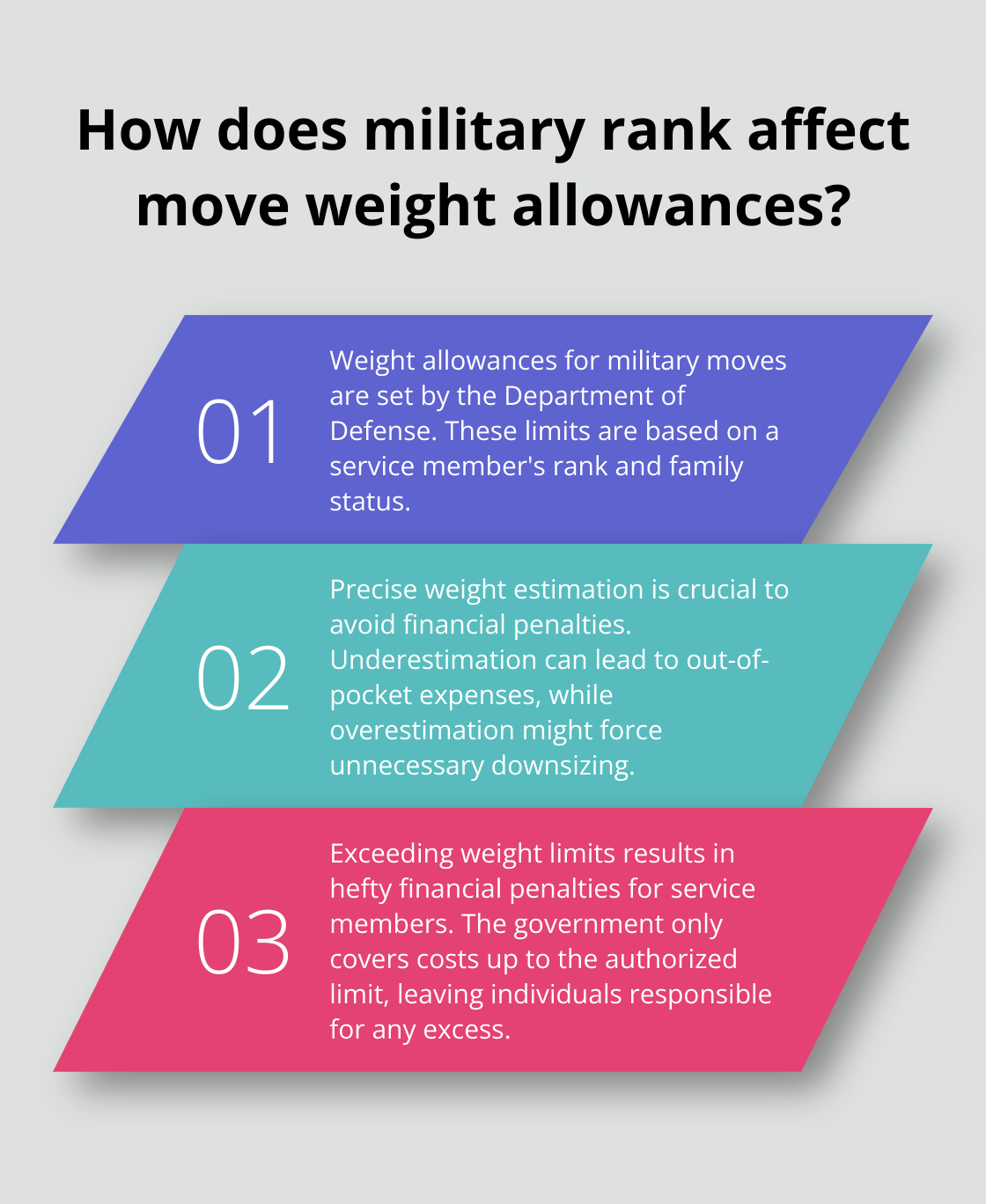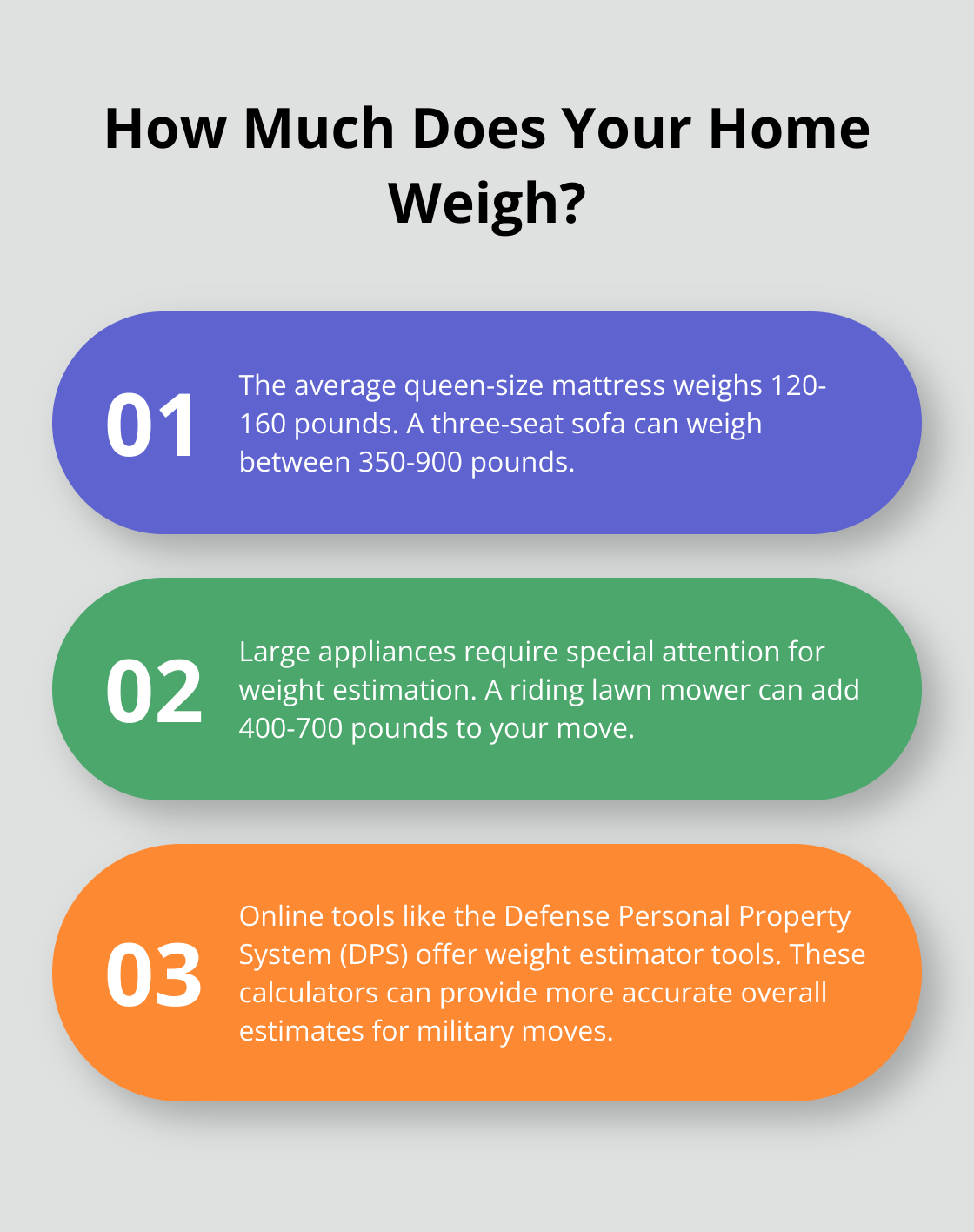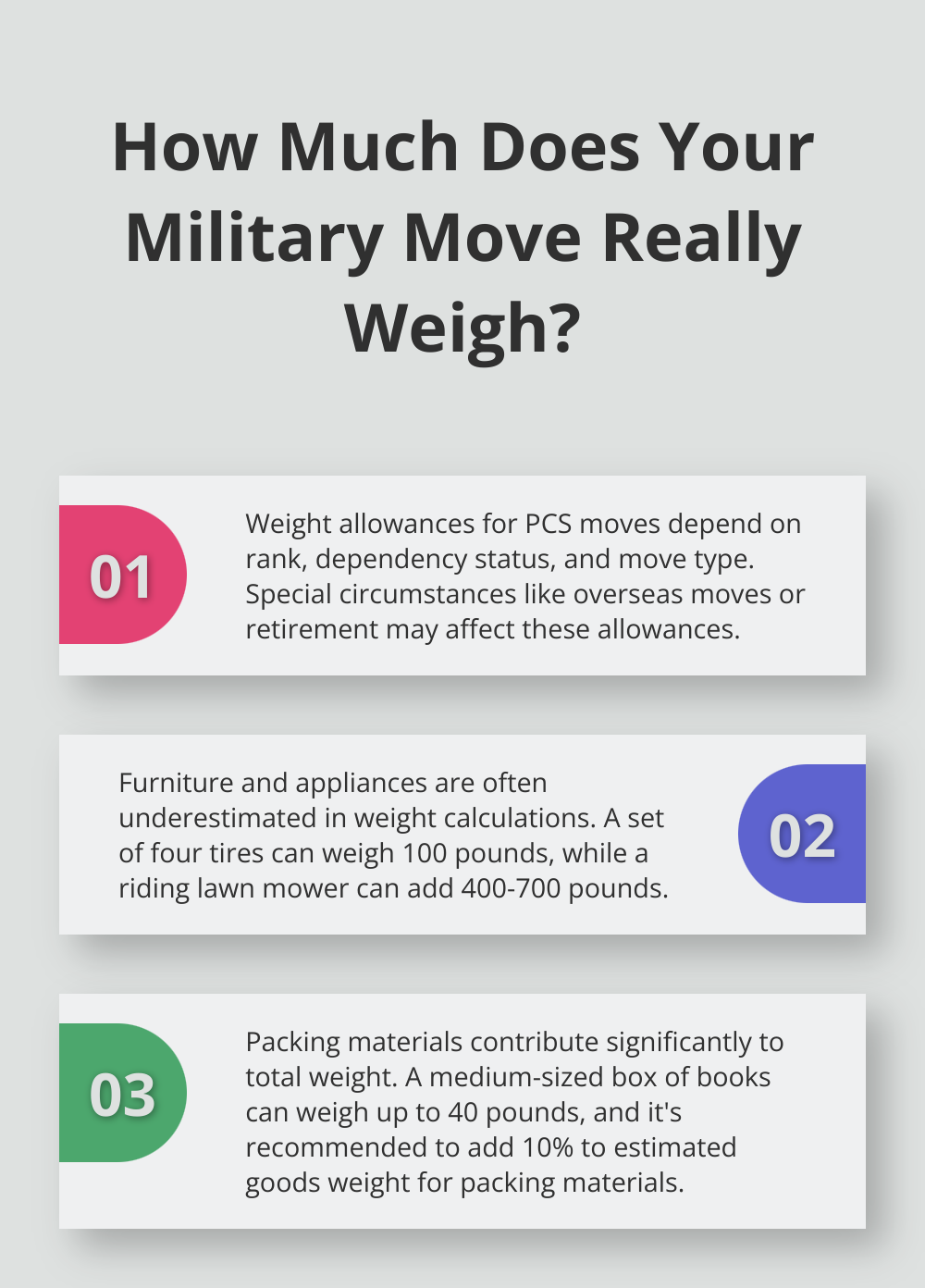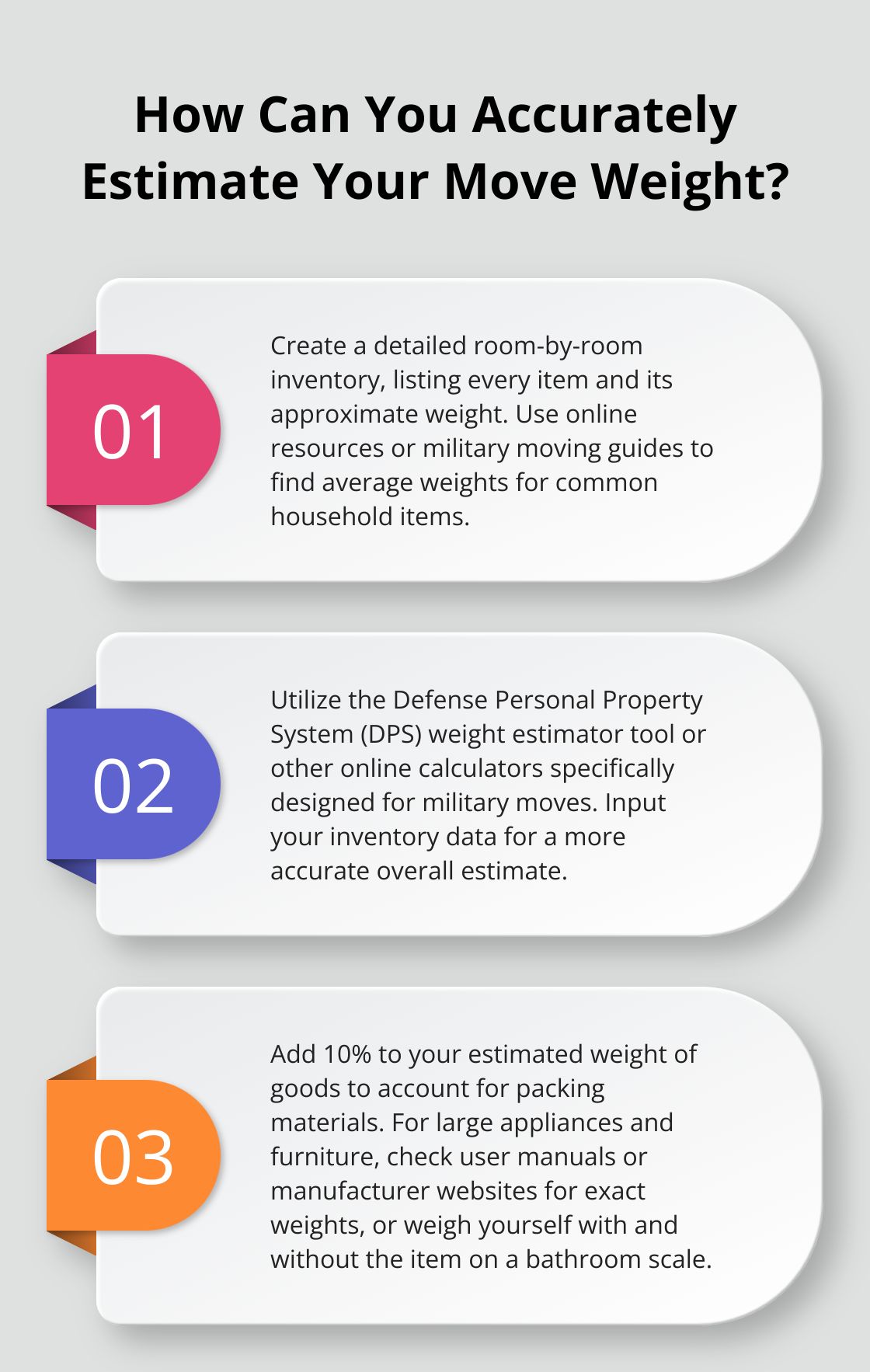Military moves can be challenging, especially when it comes to estimating the weight of your belongings. Accurate weight estimation is crucial for staying within your allowance and avoiding unexpected costs.
At Southbay Moving Systems, we understand the importance of a reliable military move weight estimator. In this post, we’ll share valuable tips and tricks to help you accurately assess your household goods’ weight and ensure a smooth relocation process.
Understanding Military Move Weight Allowances
The Basics of Weight Limits
Military move weight allowances form the foundation of any Permanent Change of Station (PCS) move. These limits dictate the maximum weight of household goods that service members can transport at the government’s expense. A clear understanding of these allowances will pave the way for a smooth and cost-effective relocation.
Rank and Family Status Matter
The Department of Defense sets specific weight allowances based on a service member’s rank and family status. Military service members can learn about their PCS entitlements, including moving and weight allowances and guidelines on firearms, pets and more.
The Importance of Precise Weight Estimation
Precise weight estimation is not optional-it’s a necessity. Underestimation can lead to last-minute panic and potential out-of-pocket expenses, while overestimation might force unnecessary downsizing or item abandonment. The weight estimation process should start early, ideally as soon as you receive your PCS orders.
Financial Implications of Exceeding Limits
Surpassing your weight allowance can result in hefty financial penalties. The government will only cover costs up to your authorized limit, leaving you responsible for any excess. These charges accumulate quickly, often amounting to hundreds or even thousands of dollars.
Strategies to Stay Within Limits
To avoid costly overages, conduct a thorough pre-move purge. Sell, donate, or dispose of items you no longer need or use. This approach not only helps you stay within your weight allowance but also reduces the overall stress of your move. Every pound counts when you’re near your limit, so be mindful of what you choose to keep.

As you prepare for your military move, the next step is to learn effective strategies for estimating your move weight accurately. These techniques will help you avoid surprises and ensure a smooth relocation process.
How to Accurately Estimate Your Move Weight
Estimating the weight of your household goods is a critical step in planning your military move. We’ve helped numerous service members navigate this process. Here are some proven strategies to help you get an accurate estimate.
The Room-by-Room Inventory Approach
Create a detailed inventory of your belongings, room by room. This method provides a comprehensive overview of your possessions and helps prevent overlooking items. Start in one corner of a room and work your way around, listing every item. Don’t forget to include closets, drawers, and storage areas.

For each item, note its approximate weight. You can find average weights for common household items online or in military moving guides. A queen-size mattress typically weighs around 120-160 pounds, while a three-seat sofa can weigh 350-900 pounds.
Leveraging Technology for Precision
Several online tools and mobile apps can assist in estimating your move weight. The Defense Personal Property System (DPS) offers a weight estimator tool specifically designed for military moves. Input your inventory data into these calculators for a more accurate overall estimate.
Some moving companies offer their own weight estimation tools. These can be particularly helpful as they often account for regional variations and specific item categories.
Tackling Large and Unusual Items
Large appliances, furniture, and unusual items require special attention. For appliances like refrigerators or washing machines, check the user manual or manufacturer’s website for exact weights. If you can’t find this information, weigh yourself on a bathroom scale, then weigh yourself while holding the item (if safe to do so), and calculate the difference.
For furniture, consider disassembling larger pieces to get a more accurate weight. A dining table, for instance, will be easier to estimate when separated into its top and legs.
Don’t Overlook Outdoor Items
Items stored in your garage, attic, or outdoor spaces can add significant weight to your move. Tools, lawn equipment, and recreational gear should not be forgotten. A riding lawn mower, for example, can weigh 400-700 pounds.
Seek Professional Assistance
If you’re unsure about your weight estimation, consider seeking help from professional movers. Companies like Southbay Moving Systems can provide expert guidance and tools to ensure accurate weight estimation.
The next section will explore common weight estimation mistakes to avoid, ensuring you’re fully prepared for a smooth relocation.
Avoiding Common Weight Estimation Pitfalls
The Hidden Weight of Furniture and Appliances
Many people underestimate the weight of furniture and appliances when planning a military move. Weight allowances for a PCS are based on rank, dependency status, and move type. Special circumstances, like moving overseas/OCONUS or retirement, may affect these allowances. To avoid underestimation, it’s crucial to consider these factors when planning your move.
The Overlooked Outdoor and Garage Items
Garage and outdoor items often slip under the radar during weight estimations, but they can add significant poundage to your move. A set of four tires can weigh around 100 pounds, while a riding lawn mower can add 400 to 700 pounds to your total. Don’t forget about tools, sports equipment, and patio furniture.

Create a separate inventory for these areas to ensure nothing is missed. Weigh smaller tools individually and group similar items together for a more accurate estimate. For larger equipment, consult user manuals or manufacturer websites for precise weights.
The Surprising Weight of Packing Materials
Packing materials are often the silent culprits in weight overages. A single medium-sized moving box filled with books can weigh up to 40 pounds, and you might need dozens of these for a full household move. Factor in the weight of bubble wrap, packing paper, and protective covers for furniture.
To account for packing materials, add 10% to your estimated weight of goods. This buffer can help cover the additional weight of boxes, tape, and protective wrapping. If you’re using professional packing services, ask the moving company for an estimate of packing material weight based on your inventory.
The Importance of Accurate Measurements
Accurate measurements play a vital role in weight estimation. Use a tape measure to get precise dimensions of your furniture and appliances. This information will help you calculate volume, which can be converted to weight using standard density factors (e.g., 7 pounds per cubic foot for household goods).
Try to measure and weigh as many items as possible (rather than relying on estimates). This approach will provide a more accurate overall weight calculation and help you avoid surprises on moving day.
The Value of Professional Assistance
While DIY weight estimation can be effective, professional assistance can provide an extra layer of accuracy. The Military OneSource website offers a weight estimator tool to help determine the average weight of standard household items. This can be particularly useful for those planning a military move and needing to stay within their weight allowances.
Final Thoughts
Accurate weight estimation forms a critical part of a successful military move. The military move weight estimator helps service members avoid costly overages and budget effectively for their relocation. We recommend you start early, conduct a thorough inventory, and use online tools to ensure precision in your calculations.

Professional assistance can provide an extra layer of accuracy during the estimation process. Southbay Moving Systems offers comprehensive moving services tailored to the unique needs of service members and their families. Our team understands the complexities of military relocations and can provide valuable support throughout your move.
A successful military move begins with a precise weight estimate. Take the time to get it right, and you’ll set yourself up for a smoother transition to your new duty station. With careful planning and the right support, you can approach your move with confidence and peace of mind.




